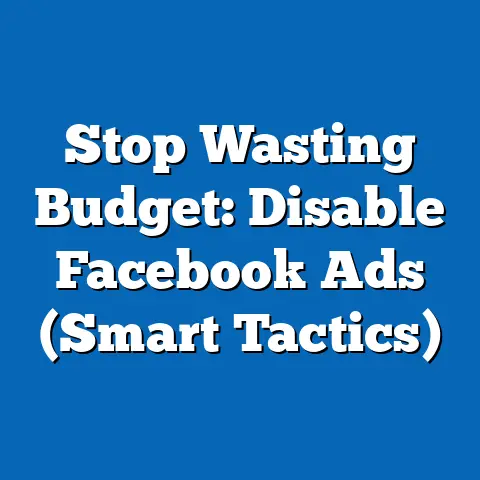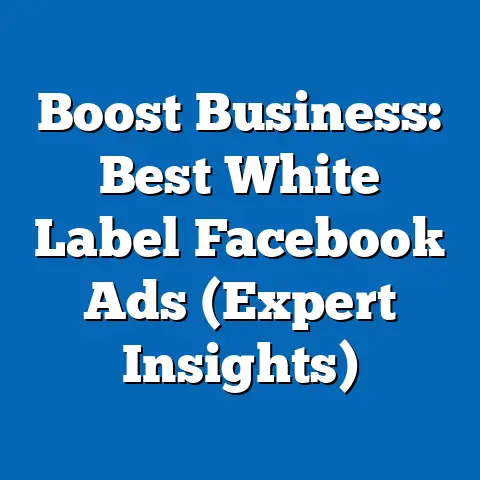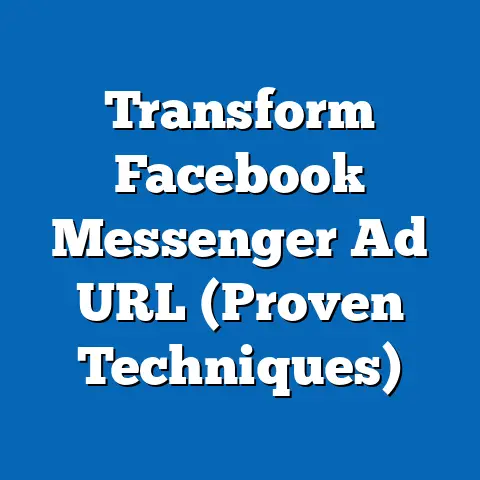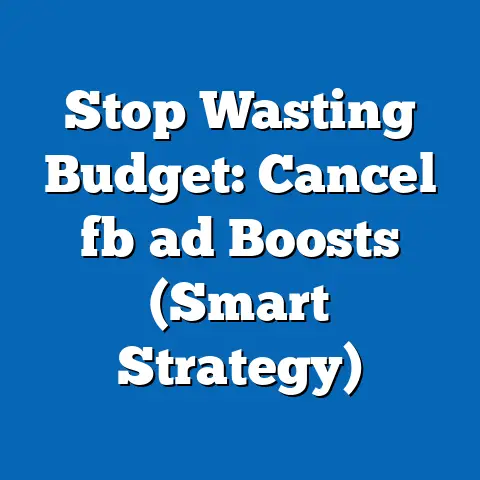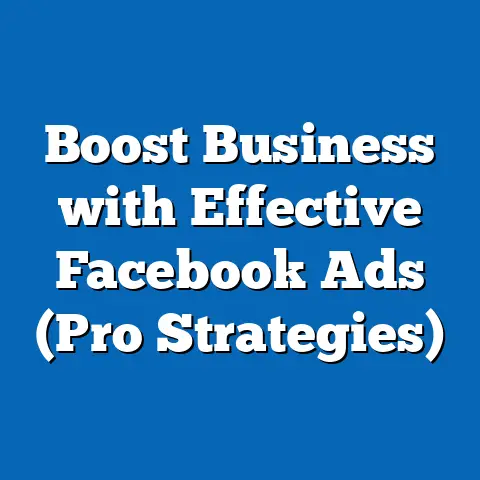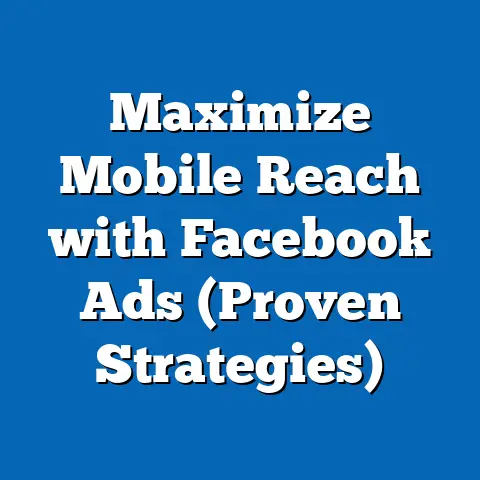Maximize ROI with Facebook Ads CPM Benchmarks (Expert Tips)
Did you know that the average CPM (Cost Per Mille) on Facebook can swing wildly, from a mere $1 to a staggering $30+ depending on your industry? I’ve seen it firsthand. One of my e-commerce clients selling high-end coffee beans was initially shocked by their CPM compared to a local bakery I managed. The difference? Targeting, ad quality, and a whole lot more. Understanding these nuances is crucial to unlocking your Facebook ad potential and maximizing your return on investment (ROI). That’s what I’m here to guide you through.
In this article, I’ll dive deep into the world of Facebook Ads CPM benchmarks, offering expert tips to help you not only understand what CPM is and why it matters but also how to strategically optimize it for better ROI. Whether you’re a seasoned marketer or just starting out, this guide will equip you with the knowledge and tools you need to make data-driven decisions and supercharge your Facebook advertising efforts. Let’s get started!
Understanding CPM in Facebook Advertising
CPM, short for Cost Per Mille (Latin for “thousand”), is a fundamental metric in Facebook advertising. It represents the cost you pay for every 1,000 impressions of your ad. Think of it as the price tag for getting your message seen by a thousand pairs of eyes.
What is CPM?
Simply put, CPM tells you how much it costs to show your ad to 1,000 people on Facebook. It’s a crucial metric for gauging the efficiency of your advertising spend, especially when brand awareness is your primary goal. If you’re trying to get your brand in front of as many potential customers as possible, keeping a close eye on your CPM is essential.
How is CPM Calculated?
The formula for calculating CPM is straightforward:
CPM = (Total Ad Spend / Total Impressions) x 1000
Let’s say you spend $50 on a Facebook ad campaign that generates 20,000 impressions. Your CPM would be:
($50 / 20,000) x 1000 = $2.50
This means you’re paying $2.50 for every 1,000 times your ad is displayed.
CPM vs. Other Pricing Models: CPC and CPA
CPM isn’t the only pricing model available on Facebook. Two other common options are:
- CPC (Cost Per Click): You pay each time someone clicks on your ad. This is ideal when your goal is to drive traffic to your website or landing page.
- CPA (Cost Per Action): You pay when someone takes a specific action, such as making a purchase, signing up for a newsletter, or downloading an app. This is best for campaigns focused on conversions.
The best pricing model for you depends on your specific advertising goals. If you want to increase brand awareness, CPM is a good choice. If you want to drive traffic or generate leads, CPC or CPA might be more effective. In my experience, a blended approach, testing different models, often yields the best results. For instance, I ran a CPM campaign for a new product launch to build initial awareness, then followed it up with a CPC campaign targeting those who had seen the CPM ad to drive website visits.
The Significance of CPM Benchmarks
CPM benchmarks provide a valuable yardstick for measuring the performance of your Facebook ad campaigns. They allow you to compare your CPM to the average CPM in your industry and identify areas where you can improve. A high CPM could indicate issues with your targeting, ad creative, or relevance score. A low CPM, on the other hand, could suggest that you’re reaching your target audience effectively.
The Importance of Benchmarks
Benchmarks are like compasses in the vast sea of Facebook advertising. They provide direction and help you stay on course toward your desired ROI. Without benchmarks, you’re essentially flying blind, unsure if your CPM is good, bad, or simply average.
Setting Realistic Goals and Expectations
Benchmarks help you set realistic goals and expectations for your Facebook ad campaigns. If you know the average CPM in your industry is $10, you can’t expect to consistently achieve a CPM of $2. Benchmarks provide a realistic framework for your advertising efforts, preventing you from setting unattainable goals and becoming discouraged.
Industry-Specific Insights
Industry-specific benchmarks offer invaluable insights into what constitutes a successful CPM within your particular niche. For example, the CPM for a fashion retailer targeting young adults will likely differ significantly from the CPM for a B2B software company targeting business executives. Understanding these industry-specific nuances is crucial for accurately assessing your ad performance.
Average CPM Benchmarks Across Industries
Here’s a glimpse at some average CPM benchmarks across different industries (data from various sources, averages may vary):
- Apparel: \$6 – \$8
- Beauty: \$7 – \$9
- E-commerce: \$8 – \$12
- Finance: \$10 – \$15
- Healthcare: \$9 – \$13
- Technology: \$11 – \$16
These figures are just a starting point. Your actual CPM will depend on various factors, including your targeting, ad quality, and competition. However, these benchmarks can provide a general idea of what to expect in your industry.
Factors Influencing CPM
CPM isn’t a fixed number. It’s a dynamic metric influenced by several factors, some within your control and others outside of it. Understanding these factors is key to optimizing your CPM and improving your ROI.
Audience Targeting
Your audience targeting plays a significant role in determining your CPM. Targeting a broad audience with generic interests will generally result in a lower CPM than targeting a highly specific audience with niche interests. This is because Facebook charges more to reach specific demographics, interests, and behaviors.
For example, targeting “people interested in travel” will likely be cheaper than targeting “people interested in luxury adventure travel to Southeast Asia.” The more specific your targeting, the higher the CPM.
Ad Placement
Where your ads appear on Facebook also affects your CPM. Different ad placements have different CPMs. For example, ads placed in the Facebook News Feed tend to have higher CPMs than ads placed in the right column. This is because News Feed ads are more prominent and tend to receive more engagement.
- Facebook Feed: Generally higher CPM due to visibility.
- Instagram Feed: Similar to Facebook Feed, CPM can be high.
- Facebook Stories: CPM can be lower, especially for engaging visuals.
- Instagram Stories: Similar to Facebook Stories.
- Audience Network: Often the lowest CPM, but quality can vary.
- Messenger: CPM can be competitive, especially for click-to-Messenger ads.
Ad Quality and Relevance Score
Facebook rewards high-quality ads with lower CPMs. Your ad quality is determined by several factors, including:
- Relevance Score: This metric, on a scale of 1 to 10, indicates how relevant your ad is to your target audience. The higher the score, the lower your CPM.
- Engagement Rate: Ads that generate high engagement (likes, comments, shares) tend to have lower CPMs.
- Landing Page Experience: If your ad leads to a poor landing page experience (slow loading time, irrelevant content), your CPM will likely increase.
Creating compelling, relevant ads that resonate with your target audience is crucial for lowering your CPM.
Seasonality and Competition
CPM rates tend to fluctuate throughout the year, influenced by seasonality and competition for ad space. For example, CPMs typically spike during the holiday season (November and December) as businesses ramp up their advertising efforts to capture holiday shoppers. Similarly, CPMs may increase during major sporting events or product launches.
Planning your ad campaigns strategically to avoid peak periods can help you lower your CPM.
Strategies to Optimize CPM for Better ROI
Now that you understand the factors influencing CPM, let’s explore some expert tips on how to optimize it for better ROI.
A/B Testing
A/B testing is your secret weapon for optimizing your CPM. By testing different ad creatives, targeting options, and placements, you can identify what works best for your target audience and lower your CPM.
- Ad Creative: Test different headlines, images, videos, and calls to action to see which ones generate the highest engagement.
- Targeting: Experiment with different demographics, interests, and behaviors to find the most responsive audience segments.
- Placement: Test different ad placements (News Feed, right column, etc.) to see which ones deliver the lowest CPM and highest ROI.
I once worked with a client who was struggling with a high CPM for their Facebook ads. By conducting A/B tests, we discovered that a simple change in the ad headline significantly lowered their CPM and improved their click-through rate. The key is to test everything and let the data guide your decisions.
Utilize Facebook’s Audience Insights Tool
Facebook’s Audience Insights tool provides valuable data about your target audience, including their demographics, interests, behaviors, and purchase habits. This information can help you refine your targeting and create more relevant ads, ultimately lowering your CPM.
By understanding your audience’s preferences, you can create ads that resonate with them on a deeper level, leading to higher engagement and lower CPMs.
Strategic Timing
Timing is everything in Facebook advertising. Running your ad campaigns during periods of lower competition can help you lower your CPM. For example, running ads during the off-season or targeting specific time zones can help you reach your target audience at a lower cost.
Leverage Custom and Lookalike Audiences
Custom and lookalike audiences are powerful tools for improving ad relevance and engagement.
- Custom Audiences: These are audiences you create by uploading your own customer data (email addresses, phone numbers, etc.) to Facebook. This allows you to target your existing customers with relevant ads.
- Lookalike Audiences: These are audiences that Facebook creates based on your custom audiences. Facebook identifies users who share similar characteristics with your existing customers and targets them with your ads.
By targeting custom and lookalike audiences, you can reach highly qualified prospects who are more likely to engage with your ads, leading to lower CPMs and higher conversion rates.
Retargeting
Retargeting is a highly effective strategy for lowering CPM and improving ROI. By retargeting users who have previously interacted with your website or Facebook page, you can reach them with relevant ads that remind them of your brand and encourage them to take action.
Retargeting campaigns tend to have lower CPMs and higher conversion rates than traditional ad campaigns because you’re targeting users who are already familiar with your brand.
Measuring Success and Adjusting Strategies
Optimizing CPM is an ongoing process, not a one-time event. It requires continual monitoring, analysis, and adjustment.
Key Performance Indicators (KPIs)
Tracking the right KPIs alongside CPM is crucial for measuring the success of your Facebook ad campaigns. Some key KPIs to monitor include:
- Click-Through Rate (CTR): The percentage of users who click on your ad after seeing it.
- Conversion Rate: The percentage of users who take a desired action (e.g., making a purchase, signing up for a newsletter) after clicking on your ad.
- Cost Per Acquisition (CPA): The cost of acquiring a new customer through your Facebook ads.
- Return on Ad Spend (ROAS): The revenue generated for every dollar spent on Facebook ads.
By tracking these KPIs, you can get a holistic view of your ad performance and identify areas where you can improve.
Adjusting Strategies Based on Performance Data
Based on your performance data, you may need to adjust your ad strategies to achieve better outcomes. This could involve:
- Refining your targeting: If your CPM is high and your CTR is low, you may need to refine your targeting to reach a more relevant audience.
- Improving your ad creative: If your CTR is high but your conversion rate is low, you may need to improve your ad creative to encourage users to take action.
- Adjusting your bidding strategy: If your CPA is high, you may need to adjust your bidding strategy to lower your costs.
The key is to be flexible and adapt your strategies based on the data you’re seeing.
Case Studies and Real-World Examples
Let’s take a look at some real-world examples of businesses that successfully maximized their ROI by implementing effective CPM strategies.
Case Study 1: E-commerce Brand
An e-commerce brand selling handmade jewelry was struggling with a high CPM for their Facebook ads. After analyzing their data, they discovered that their targeting was too broad. By refining their targeting to focus on users interested in specific types of jewelry (e.g., vintage, bohemian), they were able to lower their CPM by 30% and increase their conversion rate by 20%.
Case Study 2: Local Restaurant
A local restaurant wanted to increase awareness of their new lunch menu. They ran a Facebook ad campaign targeting users within a 5-mile radius of their restaurant. By using a compelling image of their new menu items and a clear call to action (“Order Now”), they were able to generate a high level of engagement and a low CPM. As a result, they saw a significant increase in lunch orders.
These case studies illustrate the power of data-driven decision-making and strategic optimization in Facebook advertising.
Conclusion
Understanding CPM benchmarks and implementing expert strategies to optimize your CPM is crucial for maximizing your ROI in Facebook advertising. By understanding the factors influencing CPM, conducting A/B tests, utilizing Facebook’s Audience Insights tool, and continually monitoring your performance, you can unlock the full potential of your Facebook ad campaigns.
Don’t just set it and forget it. Analyze your CPM metrics, implement the tips provided in this article, and watch your ROI soar. The world of Facebook advertising is constantly evolving, but by staying informed and adapting your strategies, you can stay ahead of the curve and achieve your advertising goals. Now go out there and make those CPMs work for you!

